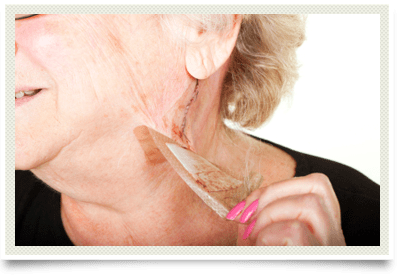
Head and Neck
Surgeries
The head and neck is an area of the body that has a high concentration of vital structures in a relatively narrow region. Surgical problems in this area can vary from outpatient procedures to complex surgical team procedures requiring extended hospitalization. The following items are a list of some of the surgical procedures performed by Dr. Govett in the head and neck region.
- Facial Skin Malignancies:
The skin of the face, nose, and ears is exposed to sunlight more than any other regions of the body. Therefore, it is expected that this area of the body has more cutaneous malignancies (basal cell carcinoma, squamous cell carcinoma, malignant melanoma) than other regions.
Fortunately, the small malignancies in this region can be managed with minor dermatologic procedures such as freezing, burning, scraping, and simple excision with closure. However, the larger tumors often require excision with examination of the margins at surgery.
The closure of the wounds is made with skin grafts, rotation flaps, and other forms of tissue transfer to make the final reconstruction as aesthetically appealing as possible. These procedures are usually performed in an outpatient surgery center. - Congenital Neck Masses:
Congenital neck masses such as a thyroglossal duct cyst and branchial cleft cyst often appear in the first to fourth decades of life after the patient suffers a sore throat or upper respiratory infection. These masses require surgical excision for pathologic confirmation and to remove a mass that has a propensity for recurrent infections. - Cervical Node Biopsy:
The anterior neck has the largest concentration of lymph nodes in the body. If these nodes become enlarged and do not resolve within a reasonable period of time, it becomes necessary to removed them for pathological identification. This procedure is usually performed in an outpatient surgery center. - Salivary Gland Surgery:
The parotid gland is the largest of the major salivary glands and is located in front of the ear. This salivary gland has a large number of benign tumors afflicting it along with multiple lymph nodes being present in the gland. Surgery for the parotid gland is a complex procedure in that the nerve that makes the face move (facial nerve) runs through the gland.
The submaxillary salivary gland is located underneath the jaw and has a propensity for stone formation and infection as the saliva produced is forced to move "uphill" into the floor of the mouth. The submaxillary salivary gland is the most commonly removed salivary gland. These procedures are often performed in the outpatient setting in an ambulatory surgical center. - Thyroid Gland:
The thyroid gland is the hormone producing gland that is located below the larynx ("Adam's Apple") on both sides of the trachea (windpipe). If a mass is located in the gland, a medical workup is initiated to evaluate the etiology of the mass.
Although most of the thyroid masses turn out to be benign goiters, there is a small incidence cancer in these lesions. If there is a question as to the pathology or there appears to be a serious problem, one lobe of the thyroid gland is removed in an outpatient setting in the ambulatory surgical center. - Parathyroid Gland:
The parathyroid glands are the small structures responsible for calcium metabolism in the body. The usual clinical manifestation of a parathyroid tumor is an elevation in the body's calcium level on a blood chemistry panel. These tumors are removed using pathological evaluation at the time of surgery to confirm the adenoma. Fortunately, the vast majority of parathyroid tumors are benign.
